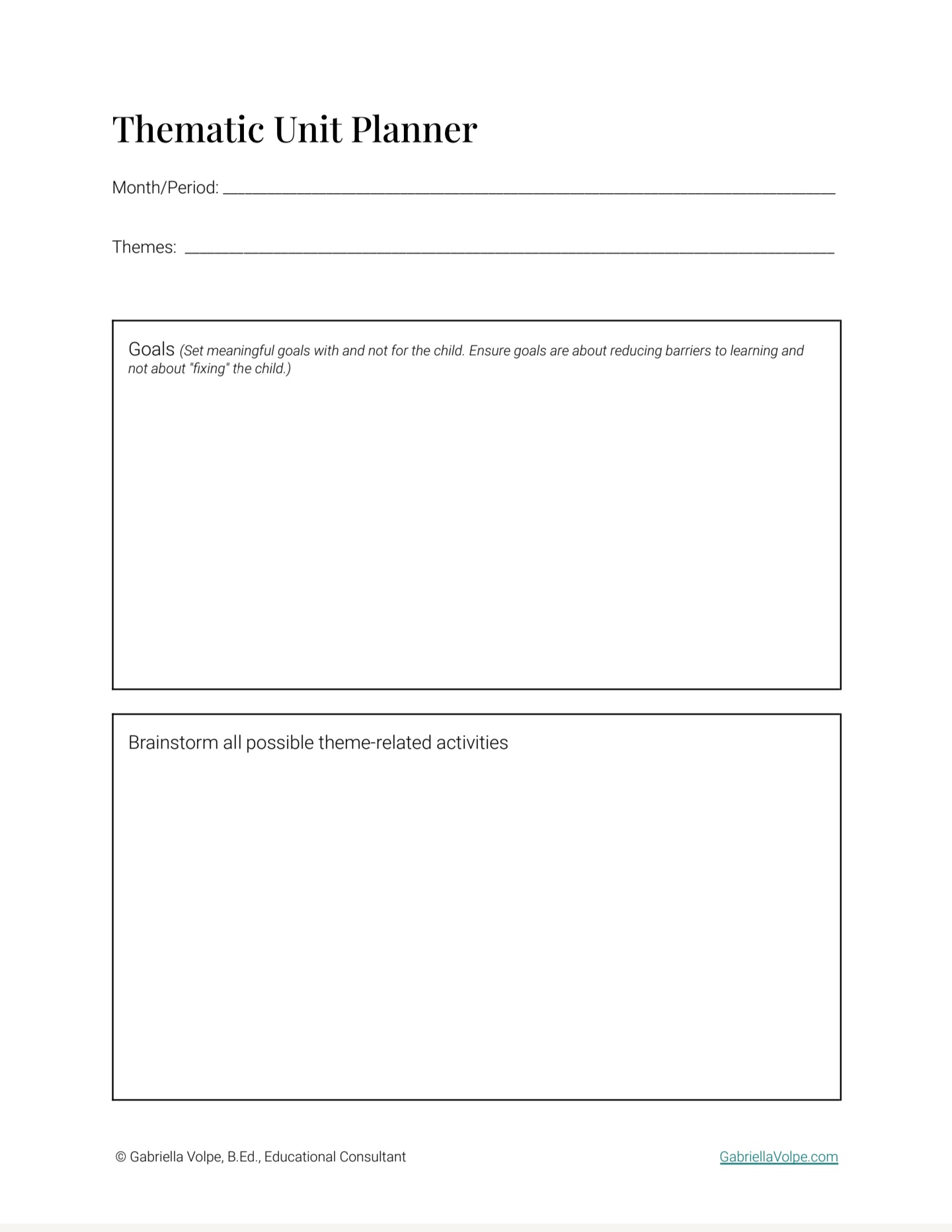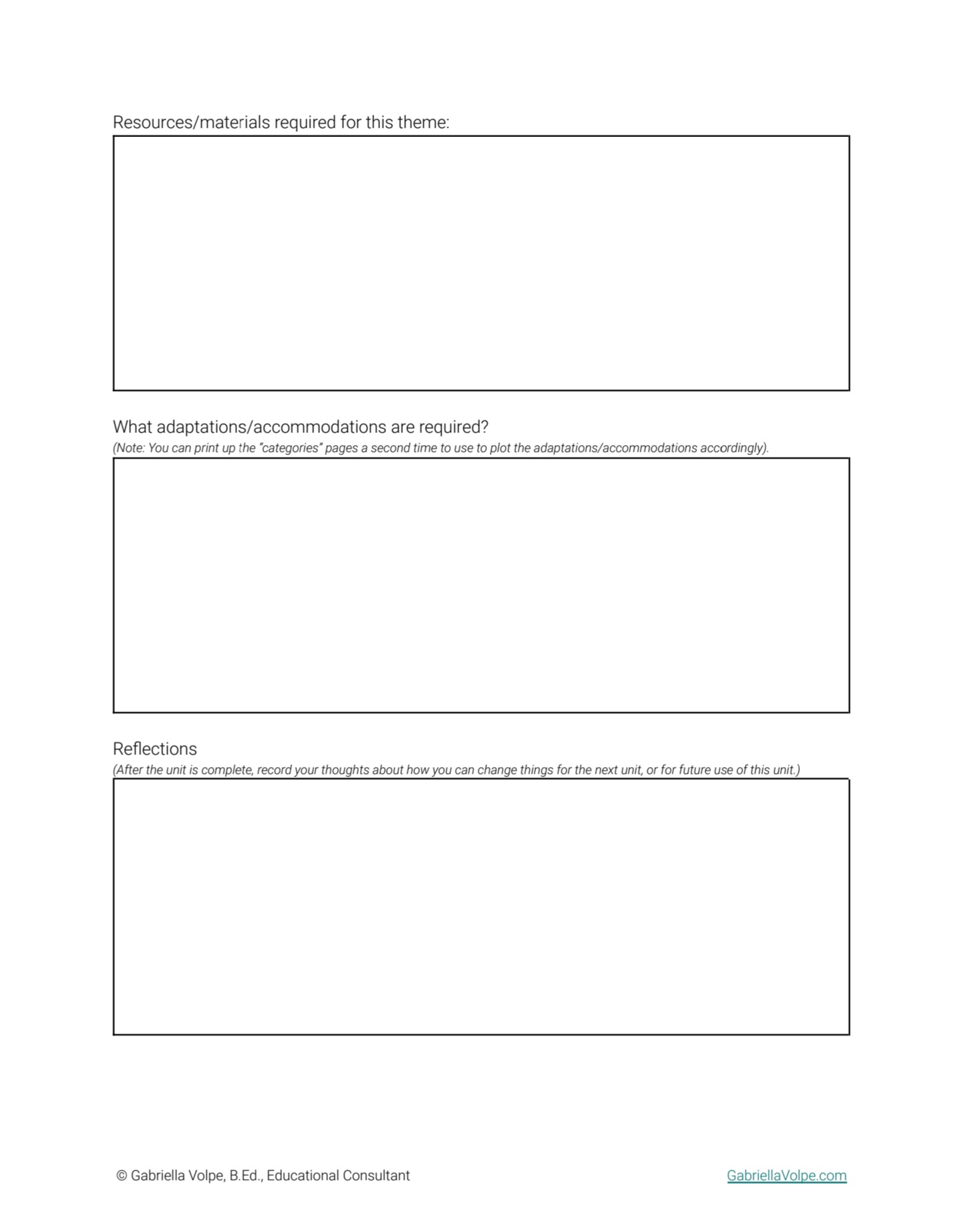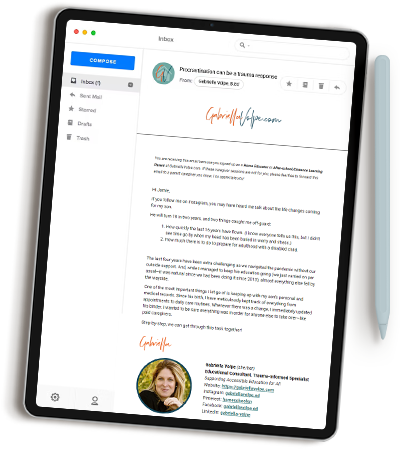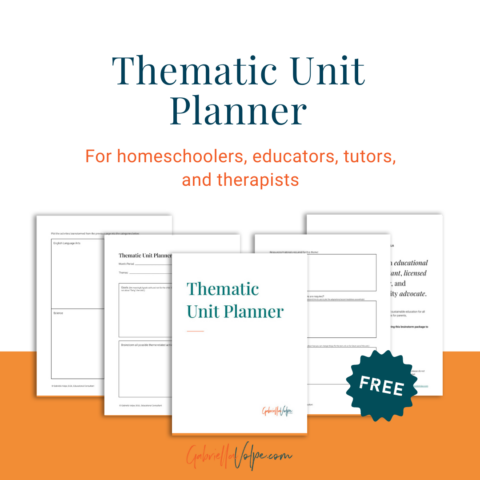Thematic units package learning for most subject areas into one neat box.
One of the simplest, and dare I say, most enjoyable methods of planning the academic year is through themes.
If you are tempted to purchase thematic units because you don’t have time to put things together yourself, this post will show you how you can truly do it successfully. It also includes a free planner for you to get it all organized in a jiffy.
Thematic units are especially beneficial for a disabled or neurodivergent child because:
- Themes provide a natural progression of learning throughout the day—within many subject/therapeutic areas
- A wide range of materials are used—matching a child’s developmental level
- The child knows what to expect within a theme, and this kind of structure is necessary for some children to thrive
- Language skills are reinforced because of the length of time in one theme and the repetition of words and skills
- The focus is on the process, not the final product, because of the time given to a theme/topic
- The child is given an opportunity to be actively involved in learning at their own pace
And, of course, planning a thematic unit can help you, the parent, educator, or clinician, remain focused throughout the month while keeping an eye out for materials/ideas for future themes you have already planned.
While you can go online to find a thematic unit fully pre-packaged, I advise against this for 4 reasons:
- They aren’t personalized.
- They probably aren’t adapted to the child’s interests, needs, and desires.
- They are often worksheet-heavy.
- They aren’t as much fun to put together.
How to Thoroughly Plan a Thematic Unit
1- Decide what theme you will focus on. Keep the child’s interests and developmental level at the forefront.
How to select a theme?
There is no right or wrong theme. Use these categories to help spark ideas for thematic units:
- Holiday/seasonal/weather-related (most popular because it helps children internalize the rhythms of their natural world no matter their age, and it can easily connect them to other people because the words/phrases/expressions used at a particular time of year will be familiar/reinforced)
- Based on a book/novel or text (e.g., Charlotte’s Web might spark an animal study)
- Science-related (e.g., the study of acid rain)
- Social studies-related (e.g., a period in our history)
- Art-related (e.g., the study of an artist, musician, or musical genres)
- Genre-related (e.g., the study of short stories or biographies)
- Based on personal interest (pay attention to what they are attracted to in daily activities, on TV, in games or toys, characters in books, sports or other physical activities, etc.)
It’s important to keep the themes and activities meaningful and relevant. I wouldn’t suggest studying kookaburras in the middle of winter if you live in North America. Change that study to that of a local bird that the child can relate to and even possibly see while outdoors in winter. If kookaburras happen to be the child’s passion, you might choose to save the unit for summer, where they can compare kookaburras to other birds.
Theme units should be meaningful and based on what the child will see, hear, and experience throughout the unit.
2 – Connect the theme to goals. You may have already outlined the goals for this learning block using the 3-month planning guide. If you didn’t, I recommend you take some time to work through that first. Once you have drafted some overarching goals, break them down into the three individual months within that quarter.
- What goals can you tackle within January’s theme? In February? In March?
Important note: Be sure the goals are neurodiversity- and disability-affirming. The idea is to create goals that reduce or remove barriers to learning, not to “fix” or change the child.
3- Organize the theme. Decide what the specific activities will be. Brainstorm freely first, then decide which are most feasible and which need adaptations. Use online ideas for inspiration. Don’t fit too much into one month. Taking more time with activities and explorations is always better than whipping through tons of ideas. Having too many ideas also creates unnecessary pressure and guilt if not tackled.
It’s always advisable to allow time for the child to absorb the concepts so they can meet the goals at their own pace.

You can find this free Thematic Unit Planner printable in the resources below. It includes a space for brainstorming possible theme-related activities for the month. It’s great to have handy as you research online.

Once you have finished brainstorming, these sheets help you to categorize the activities/ideas by subject. You will also be able to list your outings/visits, cooking/baking recipes, outdoor/nature activities, and resources/materials required. You can easily add these pages to your planner.

You also have a space to brainstorm the resources required and adaptations you plan to make within the unit.
4- Gather resources and materials. What props will you need? What supplies are required? What about books? Gather everything you need for the unit.
5- Organize the learning spaces. At the beginning of each unit, clear out the old theme, store materials, and begin with a fresh slate. Will you add it to the nature table over the course of the unit, or will you create it yourself from the get-go? What about your art wall? Playspace? Reading nook?
Get all areas ready for the new theme. You don’t have to purchase new materials. Look around your space and add as you go.
6- Adapt/modify the theme. What adaptations will you make to this theme to match the child’s developmental level but also guide them toward the intended goals? Don’t forget to integrate therapeutic goals into the theme.
Important note: Be sure the goals are neurodiversity- and disability-affirming. The idea is to create goals that reduce or remove barriers to learning, not to “fix” or change the child.
I’d love to know: Do you plan your own thematic units? What challenges do you face when putting together a unit?
- Download the Thematic Unit Planner here – The free downloadable planner; you can print as many as you need and add the sheets to your planner on a monthly basis.
Related Articles
- Planning the Home Education Year Series
- Freebie: Your 3-Month Academic and Therapeutic Planner
- Honing Passions: Using a Child’s “Fixations” as a Motivator for Learning
- When Inspiration Drives Learning, Motivation is Unnecessary
If you require assistance with adapting/modifying a thematic unit, check out my services to learn how I can support you further.
Get more resources like this one
Sign-up to my newsletter and I’ll send you email updates regarding education, accessibility, and disability justice.

By signing up for email alerts, you agree to receive updates and promotions from me. You can unsubscribe at any time.


Thank you for the printables!
I love working with themes. I always try to use themes that connect what my older son is learning with what my younger son is working on. Right now Nathan is learning about Antarctica while Wyatt learns about penguins, ice and snow and their relevant concepts.
Theme planning at its best, Jasmin! That’s exactly how to make it work for more than one child. Then, they can share their learnings with one another and the experience is that much richer! In the classroom, theme units work to meet the needs of many diverse learners. Each student takes away what is most meaningful to him/her – at his/ her own pace. Thanks for sharing this with others.